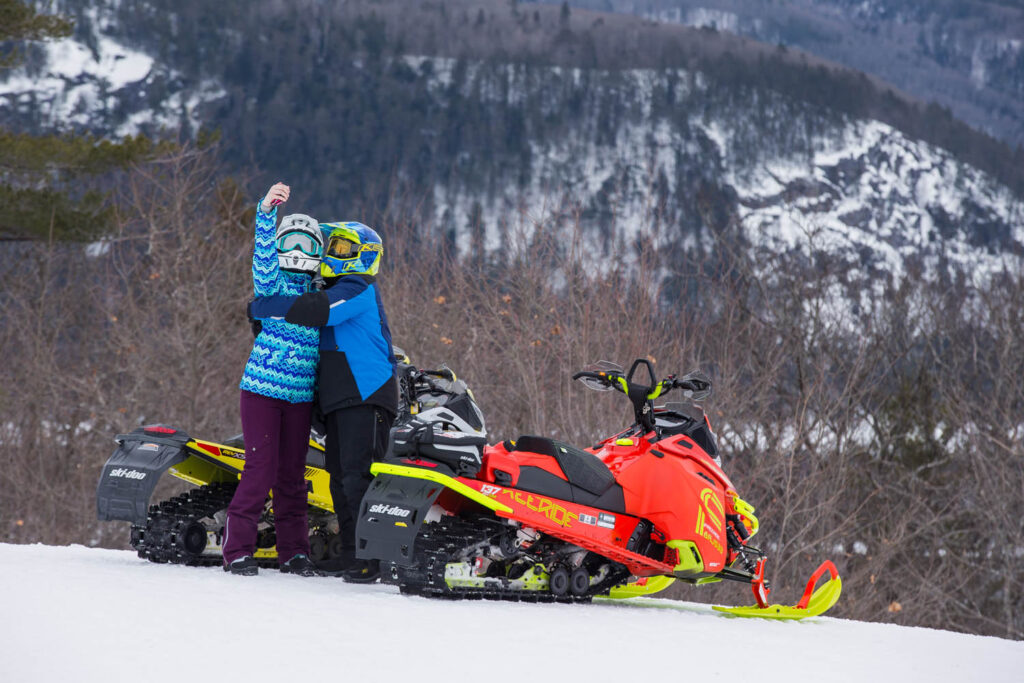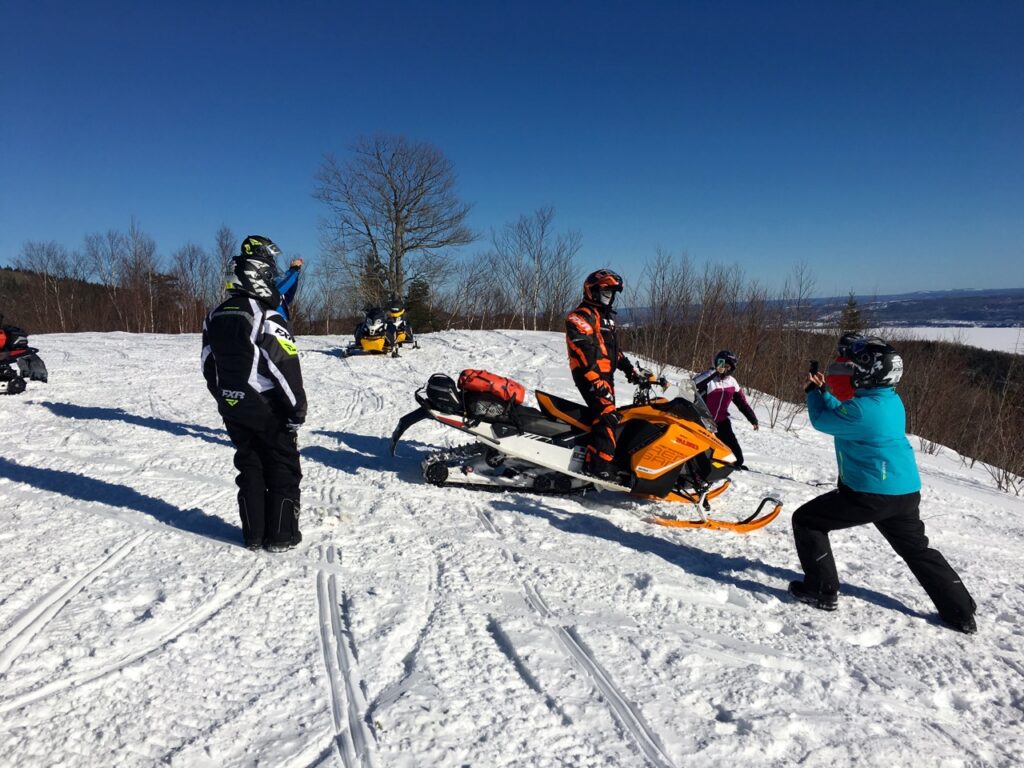How To Get Great Snowmobiling Photos…
Related: Keeping Bare Hands Warm
For me, shooting snowmobiling photos is more difficult than writing for a snowmobile magazine. This is largely because there are no rewrites on snowmobile trails. Despite going digital camera, I am still mystified. I’m plagued by bright light, sun direction, shadow, snow reflection, cloud cover and fast moving sleds.
So I’m challenged staging snowmobiling photos on snowmobile tours. Especially if I forget to remove the lens cap. At least I have a “burst” mode now on my digital camera. It allows me to take a bunch of shots lickety-split by holding down the shutter button!
Before proceeding, let me say that I’m not a trained or professional photographer. I don’t have a big expensive camera. Mine is a point and shoot Panasonic Lumix worth about $600. I don’t fiddle much with the settings, mostly just shooting on auto. Fortunately, my camera is a much better photographer than I am. So all I really have to do is to stage the shot properly. It does the rest. Thank goodness for features like zoom, stabilization, auto focus, burst and hi res.
Typically, I have to shoot a couple of hundred burst snowmobiling photos to get a handful of keepers. That said, I’ve succeeded in getting my share published in snowmobile magazines. So here are some of the things I’ve learned to increase my chances of taking decent snowmobiling photos…
Winter is Damn Cold
Unlike most outdoor photography, mine takes place in freezing cold. Various snow conditions on snowmobile trails don’t make it easy either. So one of my primary considerations is keeping everything warm enough to function on snowmobile tours.
I wear my camera around my neck under my snowmobile jacket. It’s in a special pouch that makes me look like I have a prodigious bust. I only expose it to the cold when I’m ready to shoot snowmobiling photos. This way, moving parts won’t seize, the battery will last longer, and the lens or viewfinder won’t fog up. I always carry extra charged batteries and a soft cloth just in case. The downside is the race to get my jacket open fast enough. I’ve got to get the camera out and turned on, before my subjects zoom past on the snowmobile trail.
Rider Tip: I place an adhesive toe chemical warmer in my pouch. For my iPhone, i stick a warmer on the back and carry it in a front pant pocket. Each helps keep my cameras warm and prolongs battery life.
What’s more, my shutter finger frequently gets so cold that it loses all feeling. So I keep my hands either in my snowmobile gloves or inside my jacket as long as possible while I’m waiting to shoot snowmobiling photos. Still, my shutter finger often goes numb during my efforts to capture something other than an empty trail. I have lots of those shots…
Where’s The Sun?
Sunlight is absolutely critical for taking good snowmobiling photos. Essentially, you can’t get a decent shot if you shoot into the sun. If you do, the bright light will either overwhelm your camera lens. Or it will backlight your subject so badly it will look like a black silhouette in your snowmobiling photos. So keep the sun at your back. Or at worst to the side and angle your lens away from it as much as possible.
Keeping the sun behind you isn’t alway easy while taking snowmobiling photos. So I try to plan each day’s ride to account for the position of the morning and afternoon sun. Nothing’s more frustrating than riding through great scenery with the sun in the wrong place. Sometimes I have to wait for the snowmobile trail to change direction enough that the sun is temporarily in the right place.
Of course, the sun isn’t always out. This can work for snowmobiling photos if there’s still enough light. But if it’s really overcast and dreary, your snowmobiling photos will likely be drab and unappealing. Nothing makes a photo pop like bright colours and blue sky!
Proper Set Up
When traveling with a group, I take the lead for snowmobiling photos. While riding, I try to imagine what photo ops look like ahead. When I decide that a coming scene might work, I try to get everyone stopped as soon as possible. Ideally, so we haven’t already passed that special spot. Then I move on alone up the snowmobile trail to set up for the oncoming snow machines.
Setting up for snowmobiling photos means stopping on the trail. I need to park my snowmobile to one side. It must not obstruct the trail and be out of the the shot I’m framing. If I leave it on the right side, my oncoming subjects will gravitate to the centre or even the wrong side of the trail to pass it. Either position can spoil the shot as I only want to show snowmobiles riding on the proper side of the trail.
If I park my sled on the left side, it becomes an unexpected obstacle to any snowmobilers coming from the opposite direction while I’m shooting. I used to leave my snowmobile running, while shooting. But I quickly realized that I had to be able to hear oncoming sleds from either direction to avoid being run over. It also helps to get ready by hearing the snowmobiles in my own group moving towards me (I often move far enough ahead on the snowmobile trail that we are not in visual contact).
Capturing Sleds in Motion
So now I’m set for snowmobiling photos. What else could go wrong? My companions frequently start toward me too soon, before I’m ready. They can also come on so fast I miss them altogether. Or can’t see them for snow dust. Or they can come on so slow that in the photo they will appear to be parked. They may not all come at once. Or there can be large, irregular gaps between sleds. Or maybe one is slightly out of line so it appears to be positioned beside, not behind other sleds.
My Snowmobiling Photos
All in all, I’m always amazed at ending up any useable photos. One key is shooting as hi res as possible for optimum clarity. You can always downsize a photo later to make it smaller for social media. But if it’s not high enough resolution in the first place, the quality won’t be there to make it bigger.
They say a picture is worth a thousand words. And maybe some day more of my snowmobiling photos will achieve that standard. Meanwhile, the only certain way for me to produce a thousand words about snowmobiling is with my trusty pen!
The tips and advice in this blog are the opinions of the author, may not work in every situation and are intended only for the convenience and interest of the reader, who has the personal responsibility to confirm the validity, accuracy and relevancy of this information prior to putting it to their own use.
Like This Post? Follow Me on Facebook!




